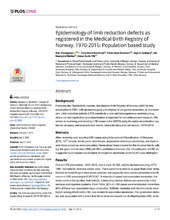| dc.Published | Klungsøyr K, Nordtveit TI, Kaastad TS, Solberg S, Sletten IN, Vik. Epidemiology of limb reduction defects as registered in the Medical Birth Registry of Norway, 1970-2016: Population based study. PLOS ONE. 2019;14(7):e0219930 | eng |
| dc.description.abstract | Background: Following the Thalidomide disaster, the Medical Birth Registry of Norway (MBRN) was established in 1967, with epidemiological surveillance of congenital anomalies as one main aim. Limb reduction defects (LRD) constitute a rare and heterogeneous anomaly group, where correct registration and classification is important for surveillance and research. We aimed at reviewing and recoding LRD cases in the MBRN using the same classification system for all years, and evaluate time trends, characteristics and risk factors, 1970–2016. Methods: After reviewing and recoding LRD cases using International Classification of Diseases (ICD), 10th version, for all years, time trends, association with major anomalies, risk factors and infant outcomes were calculated. Generalized linear models for the binomial family with log link gave relative risks (RR) with 95% confidence intervals (CI). Classification of LRD as suggested by European surveillance of congenital anomalies (EUROCAT) was attempted. Results: Overall LRD prevalence, 1970–2016, was 4.4 per 10 000, slightly increasing during 1970–1981, followed by relatively stable rates. There were more defects in upper than lower limbs. Defects in hands/fingers were most common, but unspecific descriptions prevented classification of LRD according to EUROCAT. A majority of cases had associated anomalies, the most common being other limb defects, followed by cardiac defects and anomalies in the nervous and digestive systems. From 1999, 26% of LRD cases were terminated, more than 90% of these had associated major anomalies. Stillbirth, neonatal and infant mortality were higher among infants with LRD, also related to associated anomalies. Pre-gestational diabetes was associated with a more than three times increased risk of offspring total LRD, while no association with maternal epilepsy was found. Taking folate/multivitamin supplements before and/or during pregnancy was associated with lower risk of offspring LRD (adjusted RR 0.7; 95% CI 0.6–0.9), while daily smoking did not significantly increase the risk. Conclusion: The MBRN now has information on LRD coded by ICD-10 from 1970, but information is not specific enough to use other recommended classification systems. Collecting radiographic descriptions and/or more details from hospital records would improve the quality of the registry data. Taking folate supplements before/during pregnancy may reduce the risk of offspring LRD. | en_US |

